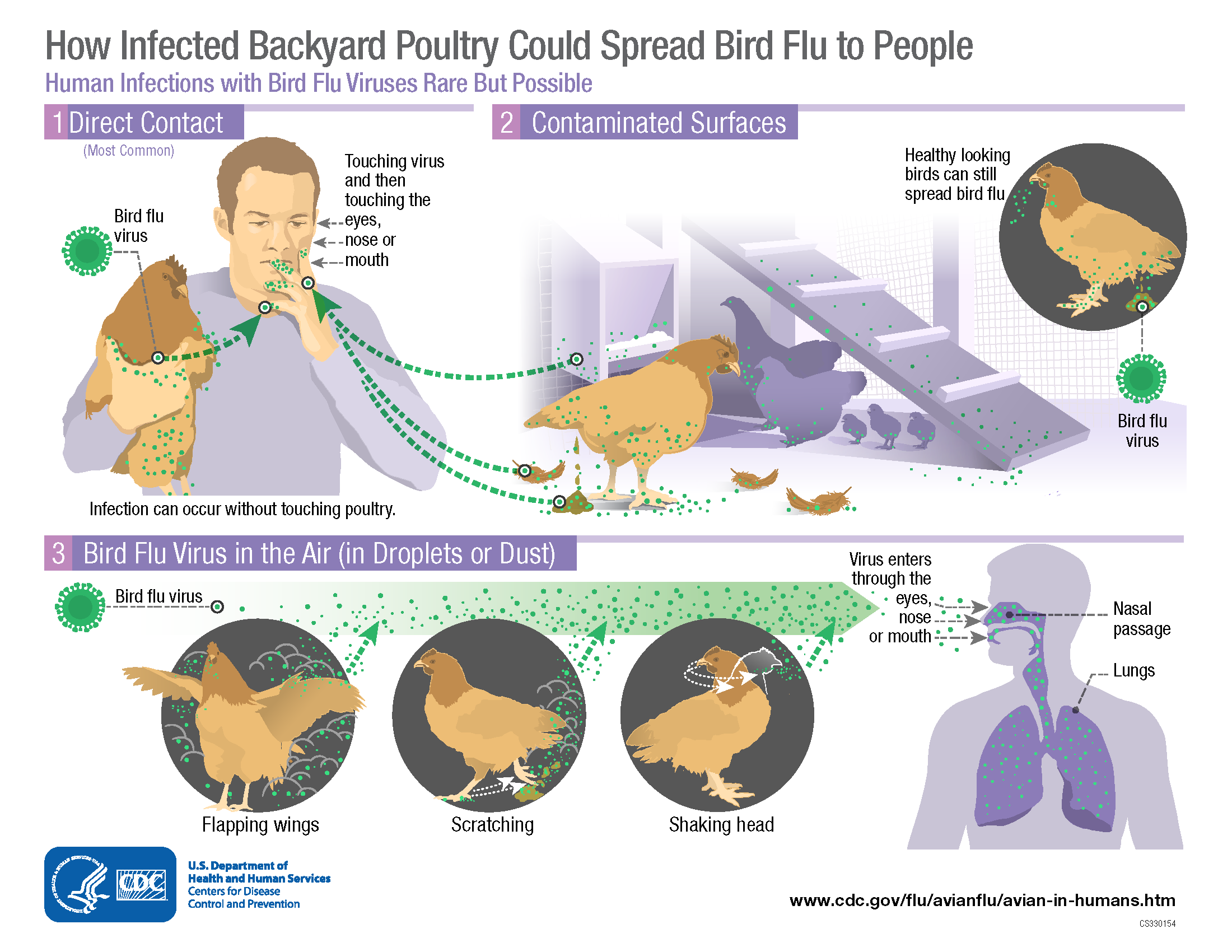What is Bird Flu?
Bird flu, also known as avian influenza A (H5N1) or highly pathogenic avian influenza (HPAI), is caused by a virus that can cause serious illness and death in birds and mammals. Human infections with bird flu viruses are rare, but they can happen when the virus gets into a person's eyes, nose, mouth, or when inhaled.
What are the symptoms of bird flu in humans?
- Eye redness or discharge
- Cough
- Sore throat
- Runny or stuffy nose
- Diarrhea
- Vomiting
- Muscle or body aches
- Headaches
- Fatigue
- Trouble breathing
- Fever (100°F or higher)
- Pneumonia
- Seizures
Symptoms can be serious and lead to death.
Who is at higher risk of getting bird flu?
People who work with or are around animals infected with bird flu or raw milk are at higher risk. This includes any contact with animal fluids, feces, feathers, or their environments.
Those at higher risk include:
Farmworkers who:
- Work with dairy cows
- Work with poultry
- Handle raw dairy products
- Work in slaughterhouses
- Work in hatcheries
Wildlife Workers
- Wildlife rehabilitation center staff and volunteers
- Pest management and animal removal personnel
- Animal control officers and shelter staff
- Zoo staff and volunteers
Other groups
- Slaughterhouse workers
- Rendering plant workers
- Live bird market workers
- Veterinary clinic staff
- Persons with sick backyard flocks
Wildlife workers, please see
Bird Flu: Working with Wildlife (PDF, 2.3MB) for more information.
How does bird flu spread?
It spreads from sick cows, birds, or other infected animals to people by:
- Breathing in dust or droplets with the virus.
- Splashing raw milk from an infected cow in your eyes, nose or mouth.
- Touching your eyes, nose or mouth with unwashed hands after:
- Touching raw milk, cow or bird feces, or other contaminated items or surfaces.
- Handling sick or dead animals infected with the virus.
- Drinking raw milk.


How do I avoid getting bird flu?
-
Avoid contact with infected animals. Avoid direct contact with birds and other animals that could be infected with bird flu. Wild birds can be infected with bird flu even if they don't look sick.
-
Get the seasonal flu vaccine. CDPH recommends that all Californians, especially workers at risk for exposure to bird flu, receive a seasonal flu vaccine. While the seasonal flu vaccine will not protect against bird flu, getting vaccinated can lower the risk of being infected with both seasonal flu and bird flu at the same time. Getting vaccinated also reduces the chance of severe illness from seasonal flu.
-
Only consume pasteurized dairy products. The bird flu virus can be present in raw, unpasteurized milk. Unpasteurized milk may contain other germs that can make you sick. Do not touch or consume raw milk or raw milk products. Pasteurized milk and dairy foods are safe to eat.
-
Cook poultry and eggs to an internal temperature of 165°F. There is no evidence that humans can get bird flu through properly prepared poultry and eggs cooked to the correct temperature. The chance of infected poultry or eggs entering the retail market is low. There are safeguards like testing of flocks and federal inspection programs. This makes it unlikely an infected bird or eggs from an infected bird will reach consumers.
How do I protect myself?
If you must have contact with birds, cows, cats, other animals or their environments, wear recommended personal protective equipment (PPE) and take extra precautions.
This includes:
- Wearing PPE
- Goggles or face shield
- NIOSH® approved respirator
- Gloves
- Coveralls
- Head cover
- Boots
- Working outdoors or in well-ventilated indoor environments.
- Washing your hands after contact with animals or their environments and before taking breaks or eating/drinking.
- Avoiding touching your eyes, nose and mouth with unwashed hands.
- Avoiding kissing or putting birds, or other animals suspected to have bird flu near face.
- Wearing dedicated work clothing and footwear and washing them to keep on-site if possible.
- Changing clothes and footwear and showering after work.
- Monitor yourself and family members for signs of influenza-like illness for 10 days after last contact with an ill animal. Report any illness to your health care provider.
See Worker Protection from Bird Flu (PDF, 1.2MB) and Protect Yourself from Bird Flu When Working with Infected Poultry (PDF) for more information.
What if I have symptoms of bird flu?
- Tell your employer right away.
- Contact your
local public health department right away to arrange for testing and treatment. Tell them you may have been exposed to bird flu.
-
When testing, you may get a few swabs taken. If you have an eye infection, an eye swab may be taken. In exposed persons with eye infections, eye swabs are most likely to detect bird flu.
- For information about worker rights, such as workers compensation or paid sick leave, visit CalOSHA's What Workers Need to Know About Bird Flu.
See Guidance for People with Possible or Confirmed Bird Flu Infection for specific information about what to do if you have symptoms of bird flu.